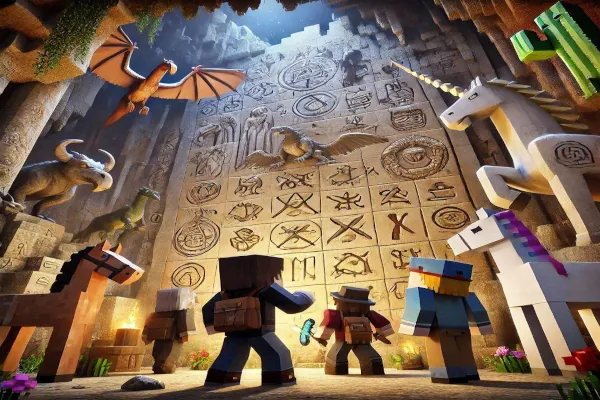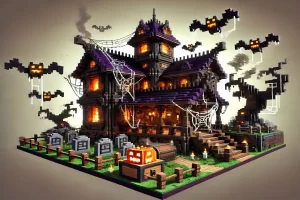Real-World Myths and Legends in Minecraft Horror Mods
Minecraft is a game that needs little introduction. Its sandbox nature and simple blocky graphics have made it one of the most beloved and influential games of all time. Over the years, Minecraft has transcended its roots as a creative building game, evolving into a platform where players can experience almost any genre imaginable. From adventure maps to puzzle challenges, Minecraft has allowed players to reimagine classic genres in a pixelated world. Among these genres, horror has found a particularly intriguing niche, with countless mods bringing spine-chilling experiences to the game.
The appeal of horror mods in Minecraft is undeniable. What makes them so captivating is not only the eerie, suspenseful atmosphere but also their deep connection to real-world myths, urban legends, and cultural folklore. Minecraft’s flexible world-building mechanics offer the perfect canvas to bring these stories to life—transforming familiar creatures and legends from various cultures into something truly terrifying within the blocky world. These mods don’t just add new monsters or scares; they pull from the global collective imagination, weaving ancient myths and stories into the gameplay.
In this post, we’ll explore how Minecraft horror mods breathe new life into global legends. From folklore-inspired monsters to terrifying supernatural entities, these mods create an immersive horror experience that feels both unsettling and familiar. Get ready to dive into the dark side of Minecraft, where the creatures of myth and legend await!
From urban legends to ancient folklore, Minecraft horror mods have drawn inspiration from a wide range of real-world myths, turning the blocky game into a gateway to the supernatural. Here are some standout examples of how myths and legends come alive in Minecraft, offering players a spine-chilling experience.
The Legend of Herobrine
The story of Herobrine is one of Minecraft’s most enduring myths. Originating as a creepypasta, Herobrine is said to be a ghostly figure with glowing white eyes who haunts players by creating mysterious structures and leaving behind eerie signs of his presence. The Herobrine mod capitalizes on this folklore, adding Herobrine into the game as a malevolent entity. Players might catch glimpses of him in the distance, hear unsettling noises, or suddenly face attacks that make them question whether they’re truly alone in their world.
The Slender Man Myth
Slender Man, a modern urban legend born from internet horror culture, is the perfect fit for Minecraft horror mods. Known for his tall, faceless appearance and ability to stalk his victims, the Slender Man mod introduces chilling encounters into the game. Players exploring dark forests or abandoned areas might find themselves being watched—or worse, hunted—by this unnerving figure. The mod uses suspense and sudden jump scares to bring the Slender Man myth to life in a way that’s both terrifying and immersive.
The Wendigo from Native American Folklore
The Wendigo, a creature rooted in Native American folklore, embodies themes of greed, isolation, and cannibalism. In Minecraft, the Wendigo mod places players in desolate, snowy landscapes where they must survive while being hunted by this monstrous predator. The Wendigo is not just a physical threat—it’s a reminder of the dangers of succumbing to primal fears and selfishness. The mod enhances the sense of isolation and dread with eerie sounds and sudden appearances of the creature.
How Minecraft Mods Adapt Real-World Myths into its world
Bringing ancient legends and myths into Minecraft’s sandbox environment is no small feat. Yet, modders have found innovative ways to translate these chilling tales into the game’s unique visual and gameplay style. Here’s how they achieve it:
Visual and Environmental Storytelling
Despite its pixelated aesthetic, Minecraft has a remarkable ability to create immersive environments, and horror mods take full advantage of this. Legendary creatures are recreated using blocky designs, retaining their iconic features while blending seamlessly with Minecraft’s art style. Environments like dark forests, snowy wastelands, or abandoned villages add an eerie backdrop that enhances the mythological storytelling.
Mods often use custom biomes and structures to immerse players further. For example, a haunted mansion might house Baba Yaga, complete with unsettling interiors and cryptic details that hint at her mythical origins. The juxtaposition of Minecraft’s simplicity with these ominous settings creates a unique, unsettling atmosphere.
Integrating Mythological Lore into Gameplay
Myth-inspired mods go beyond surface-level visuals by embedding rich lore into the gameplay. Players might uncover journals, ancient carvings, or NPCs recounting stories that introduce them to the legend at hand. These elements transform the mod into a narrative experience, encouraging players to delve deeper into the world.
Many mods include quests or puzzles rooted in the mythological source material. For instance, defeating a Wendigo might require solving a riddle tied to its folklore, or summoning Herobrine could involve piecing together cryptic clues scattered throughout the world. These mechanics create a sense of purpose and tie the gameplay directly to the myth being explored.
Fear Factor: How Mods Use Mythology to Build Tension
The key to adapting myths into horror mods lies in harnessing their inherent fear factor. Myths often draw on primal fears like isolation, betrayal, or the unknown, which Minecraft mods amplify through suspenseful gameplay. Procedurally generated worlds ensure that players can never fully predict what’s lurking around the corner, adding to the tension.
Jump scares, unsettling sounds, and sudden appearances of legendary creatures like the Banshee or Slender Man make the experience all the more harrowing. By blending mythological terror with Minecraft’s unpredictability, these mods keep players on edge, ensuring an adrenaline-pumping adventure.
Through a combination of storytelling, design, and gameplay mechanics, Minecraft horror mods breathe life into real-world myths, turning ancient tales into interactive experiences that captivate and terrify players in equal measure.
The Cultural Impact of Real-World Myths in Minecraft Horror Mods
Horror mods in Minecraft don’t just provide thrills—they also serve as a unique medium for cultural storytelling, introducing players to the rich world of myths and legends from across the globe. Here’s how these mods have left a significant cultural imprint:
Preserving Folklore Through Minecraft Mods
In a digital age, preserving folklore and oral traditions can be challenging. Minecraft mods take a creative approach by translating these age-old stories into interactive experiences. From Native American Wendigo myths to Slavic tales of Baba Yaga, these mods ensure that cultural narratives continue to be shared, albeit in a modern, engaging format. Players don’t just read or hear about these myths—they live them within the game.
Introducing Players to Global Myths and Legends
Horror mods act as cultural gateways, sparking curiosity about the origins of the legends they depict. A player encountering the Banshee or Slender Man in Minecraft might be inspired to research their Celtic or modern origins, learning about the cultural significance behind these chilling figures. By incorporating myths from diverse traditions, these mods encourage players to explore stories beyond their own cultural context, fostering greater appreciation for global heritage.
The Role of Mythological Storytelling in Global Minecraft Communities
Minecraft’s extensive community is inherently collaborative and global, making it an ideal platform for sharing mythological storytelling. Creators from different regions bring their local legends into the game, enabling cross-cultural exchanges within the community. Forums, YouTube videos, and modding platforms become hubs where players discuss and explore the myths they’ve encountered, building a shared appreciation for cultural diversity.
These mods also provide a platform for reimagining folklore, allowing communities to add their interpretations to traditional stories. This blending of old and new not only keeps myths relevant but also strengthens connections between players worldwide, united by their shared love for storytelling and adventure.
Through their adaptation of real-world myths, Minecraft horror mods don’t just entertain—they educate, preserve, and celebrate the cultural heritage of legends from around the world, making them a powerful tool for global storytelling.
Tips for Fully Immersing Yourself in Myth-Based Horror Mods
To truly experience the spine-chilling thrill of myth-based horror mods in Minecraft, immersion is key. By making a few tweaks and thoughtful adjustments, you can transform your gaming session into an unforgettable journey through the eerie and unknown.
Using Shaders and Resource Packs to Enhance the Horror Atmosphere
One of the best ways to bring myths to life in Minecraft is by installing shaders and resource packs. Shaders like Sildur’s Vibrant Shaders or SEUS can amplify lighting effects, creating haunting shadows and flickering torches that enhance the mod’s eerie vibe. Resource packs, tailored to specific horror mods, can replace the standard textures and sounds with more realistic or terrifying alternatives, ensuring every corner feels alive with mythological dread.
Setting the Right Mood: Adjusting Lighting, Sound, and Gameplay Settings
For maximum immersion, tweak your game settings to set the perfect ambiance:
- Lighting: Lower the brightness to embrace the darkness. This simple step intensifies the fear factor, making every shadow seem like a potential threat.
- Sound: Use headphones to fully appreciate the mods’ eerie soundscapes. From distant wails to unsettling whispers, these auditory cues will send shivers down your spine.
- Gameplay: Turn off HUD elements for a more cinematic experience. Without distractions, you’ll feel even more immersed in the unfolding myths.
Multiplayer vs. Solo Gameplay: Sharing the Myth Experience
- Solo Play: Exploring myth-based horror mods alone heightens the sense of vulnerability and isolation, allowing you to experience the legend’s terror in its purest form. The silence of solitude amplifies the suspense, making every moment more gripping.
- Multiplayer: Sharing the experience with friends adds a dynamic layer of fear. Coordinating efforts to face legendary creatures or unravel ancient mysteries builds tension and excitement. The shared screams and laughs also make for memorable moments, especially when facing the unexpected twists horror mods are known for.
Conclusion
Real-world myths and legends have long captivated humanity, weaving tales that evoke awe, curiosity, and fear. When these ancient stories are brought into the digital realm through Minecraft horror mods, they gain new life in a uniquely immersive way. From shadowy figures and ghostly apparitions to cursed forests and ominous wails, these mods transform Minecraft‘s blocky landscape into a chilling canvas for storytelling.
These myth-inspired horror mods are more than just thrilling gameplay experiences; they act as digital bridges to cultural preservation. By exploring legends from around the world, players not only engage with universal themes of mystery and fear but also gain insight into the diverse traditions that shaped these stories. The combination of folklore and Minecraft’s open-ended creativity amplifies their impact, creating a blend of gaming and mythology that resonates deeply.




